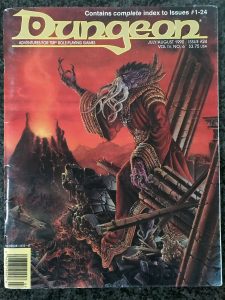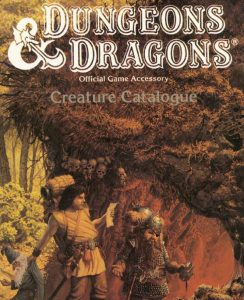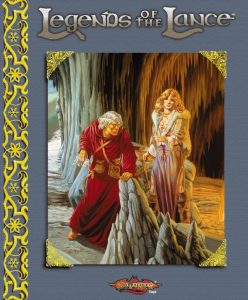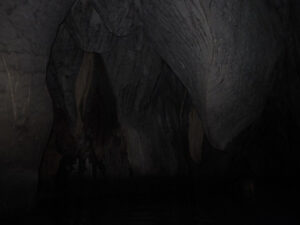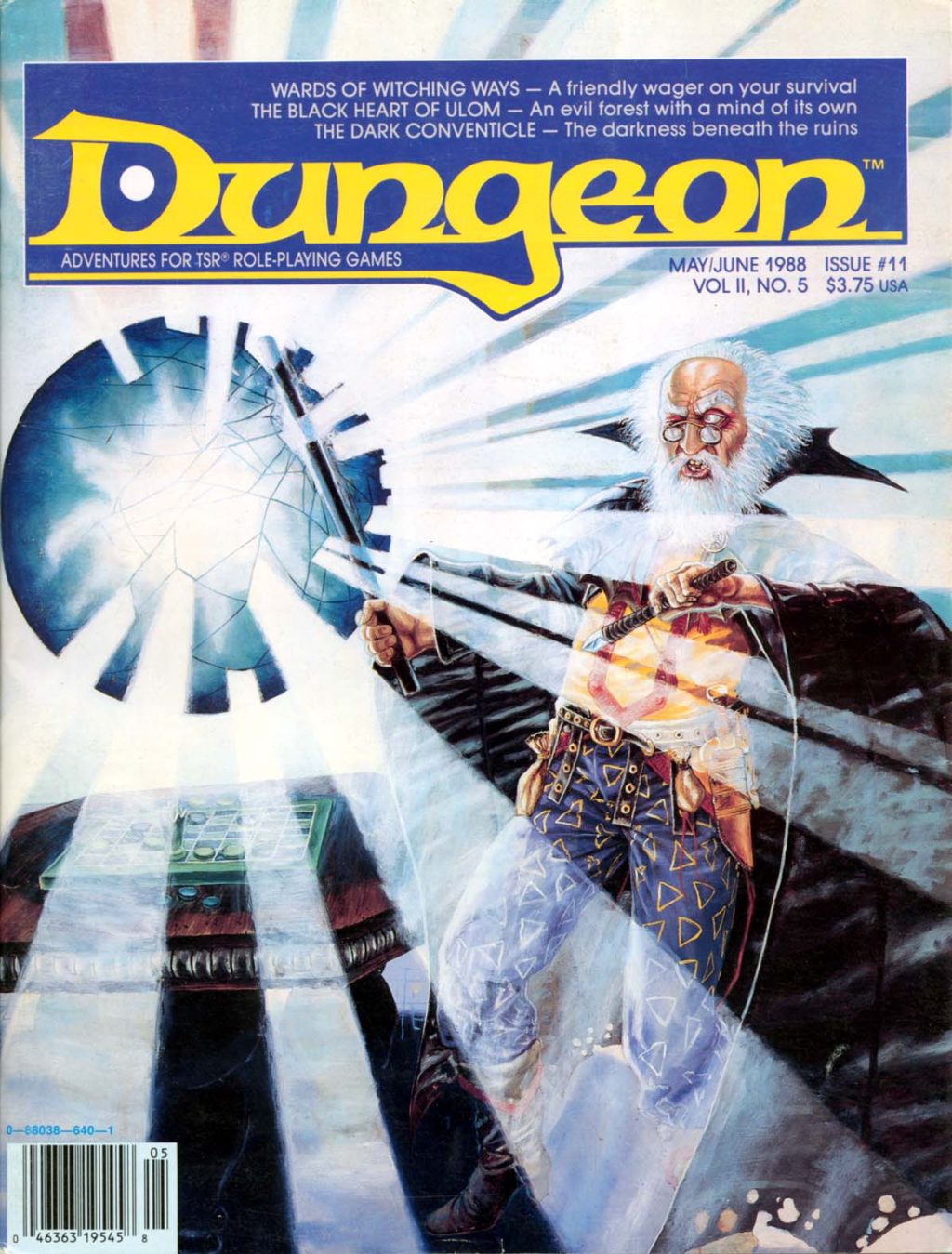
Dungeon Magazine Number 11 invites its readers into a world where creativity meets adventure and where the art of roleplaying is celebrated with an enthusiasm that only true devotees can understand. From the moment one opens its pages, there is an unmistakable sense that this is not just a magazine but a living record of a community dedicated to exploring the fantastical and the mysterious.
The contents of this issue, though presented in a straightforward list that includes letters, The Dark Conventicle, The Wooden Mouse, The Black Heart of Ulom, and Wards of Witching Ways, belie the depth and richness of the material contained within. Each section stands as a testament to the ingenuity and passion of both the writers and the readers who have shaped the world of dungeon adventures.
The issue opens with a collection of letters that capture the heartbeat of a burgeoning roleplaying community. In these missives, readers share their triumphs and tribulations, their memorable encounters in shadowy dungeons and perilous caverns, and their thoughtful critiques of the game's evolving rules. The letters serve not only as a forum for praise and criticism but also as an intimate conversation between creators and players. They reveal a sense of camaraderie and mutual respect that goes beyond the mere exchange of opinions; they are a window into the collective soul of a group united by a common love for exploration, imagination, and the thrill of discovery.
Following this lively correspondence, the narrative shifts to a darker tone with the piece entitled The Dark Conventicle. The title alone conjures images of secret meetings held in hidden chambers where whispers of forbidden lore and ancient rituals abound. In this story the reader is drawn into a world that is both menacing and mesmerizing, where every shadow seems to hide a secret and every echo speaks of long-forgotten mysteries. The prose is rich and atmospheric, evoking a palpable sense of dread and anticipation that builds slowly as the narrative unfolds.
One cannot help but be reminded of the age-old tradition of gothic tales where the boundary between the mundane and the supernatural is blurred. The Dark Conventicle is not merely a story of horror but also an invitation to reflect on the nature of fear itself. It challenges the reader to confront the unknown and to embrace the idea that sometimes the most terrifying monsters are those that lurk within the recesses of our own imagination.
In the midst of this brooding narrative the magazine offers a stark contrast with The Wooden Mouse. The title of this piece is immediately intriguing, suggesting both whimsy and the potential for subversive humor. One might expect from such a title a tale that is lighthearted and unexpected-a playful departure from the somber themes of the previous narrative. The Wooden Mouse appears to be a story that embraces the absurdities inherent in a world where even the most unassuming objects can take on a life of their own.
In its pages the reader may find a narrative that challenges conventional expectations, one where the humble wooden mouse becomes a catalyst for adventure, mischief, or even a surprising twist of fate. The charm of this tale lies in its ability to use humor to disarm the reader, offering a respite from the tension of darker themes while simultaneously provoking thought about the unexpected sources of magic and wonder in a game that is defined by its unpredictability.
As the issue progresses the tone grows even more somber with The Black Heart of Ulom. The title evokes a sense of fatalism and despair, hinting at a story where darkness has seeped into the very core of a once-esteemed entity. In this narrative the reader is likely led on a journey that explores themes of corruption and loss, where the pursuit of power has left behind a void filled only with sorrow and malice.
The Black Heart of Ulom is a meditation on the price of ambition and the consequences of succumbing to forces that are beyond mortal control. It is a narrative that invites the reader to contemplate the fragile balance between light and dark and to question whether redemption is ever truly possible when the seeds of corruption have been sown deep within the soul of a person or a place. The prose here is measured and evocative, painting a picture of decay and desolation that is both haunting and beautifully tragic.
Concluding the contents of this issue is a piece entitled Wards of Witching Ways, a title that immediately suggests a focus on the arcane and the mysterious. This section likely explores the intricate systems of magical defenses and the esoteric lore that underpin the art of spellcasting. In a game where magic is as much a tool as it is a mystery, understanding the nature of wards and enchantments is essential for both the player and the dungeon master.
Wards of Witching Ways offers a glimpse into the careful craftsmanship that goes into constructing magical barriers, and the ancient wisdom required to both create and dismantle them. The narrative here may well provide practical insights into the theory and practice of magic within the game world, weaving together historical lore with imaginative scenarios that challenge the reader to think creatively about the use of magic. It serves as a bridge between the theoretical underpinnings of game mechanics and the lived experience of adventuring.
Taken together, the contents of Dungeon Magazine Number 11 form a cohesive whole that is greater than the sum of its parts. Each piece, whether it is a letter from an ardent fan or a carefully crafted narrative steeped in atmosphere and intrigue, contributes to a larger dialogue about the nature of roleplaying and the art of storytelling. The magazine is more than just a repository of rules and adventures; it is a celebration of a culture that prizes imagination, innovation, and the relentless pursuit of new experiences.
The letters capture the voice of the community, a chorus of individual experiences that resonate with a shared passion for adventure. They reveal the challenges of mastering a game that is as complex as it is rewarding, and they offer insights into the myriad ways in which players have made the game their own. In the process they help to foster a sense of belonging and mutual respect that is as crucial to the success of any community as the rules themselves.
The Dark Conventicle, with its slow-building atmosphere of dread and mystery, reminds the reader that every dungeon holds secrets waiting to be uncovered and that sometimes the greatest challenges lie not in the physical dangers that lurk in the dark but in the psychological battles that rage within the mind. It is a story that underscores the timeless appeal of gothic narratives, inviting players to lose themselves in a world where fear and fascination are inextricably linked.
The Wooden Mouse, by contrast, injects a note of levity and surprise into the proceedings. It is a testament to the idea that even in a realm defined by epic battles and dark curses, there is always room for a bit of humor and whimsy. This piece challenges the conventional notion of what is worthy of an adventure, suggesting that sometimes the most extraordinary tales can emerge from the most unremarkable of beginnings.
The Black Heart of Ulom deepens the exploration of the game's darker themes, offering a narrative that is as much about the human condition as it is about fantastical elements. It speaks to the inevitable struggle between light and dark, hope and despair, and the eternal quest for redemption that lies at the heart of every heroic journey. Finally, Wards of Witching Ways offers both practical and mystical insights, blending the intellectual rigor of game mechanics with the wonder of ancient lore.
What makes Dungeon Magazine Number 11 so memorable is the way it encapsulates the spirit of a time when roleplaying was still a relatively new and evolving art form. In its pages one finds not only the seeds of innovative ideas that would come to define a genre but also the raw, unfiltered passion of a community that was unafraid to push boundaries and experiment with new concepts. The magazine is a snapshot of a moment in time when every adventure was an opportunity to explore the unknown, and every new rule or narrative twist was a step toward a richer, more immersive experience.
It is a reminder that the true magic of a roleplaying game lies not in the perfection of its mechanics or the polish of its production but in the shared experiences of those who gather around a table, dice in hand, ready to venture into worlds of limitless possibility. Dungeon Magazine Number 11 stands as a lasting tribute to that spirit.
It captures the essence of what it means to be an adventurer-a willingness to embrace the unexpected, to challenge the status quo, and to find joy in the journey even when the path is fraught with danger. The contributions within its pages continue to inspire and inform, offering both practical advice and imaginative storytelling that have helped to shape the way roleplaying games are enjoyed today.
In reading through its contents one can almost hear the echoes of laughter, the tension of a suspenseful encounter, and the quiet determination of heroes who refuse to be defeated by the darkness. Each story, each letter, each carefully crafted narrative is a celebration of the enduring power of imagination and the timeless allure of adventure.
Dungeon Magazine Number 11 is more than a relic of the past; it is a beacon that illuminates the creative possibilities inherent in every game, a call to arms for all those who believe in the transformative power of storytelling. Its pages remind us that every great adventure begins with a single step into the unknown and that the true measure of an adventurer is not the battles they win but the courage they show in facing the challenges that lie ahead.
